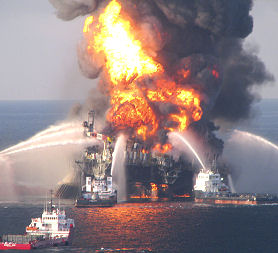Flawed cement used on BP Gulf oil rig
Contractor Halliburton used flawed cement on the Gulf of Mexico oil well which may have contributed to the blowout that sparked the biggest offshore spill in US history, a report finds.

Halliburton’s shares tumbled as much as 16 per cent after a White House panel criticised the cement job on the well, raising investor fears that the contractor may have to bear some of the clean-up costs.
The US National Oil Spill Commission released a letter detailing the panel’s findings on the Deepwater Horizon oil rig disaster.
While not absolving BP of responsibility the report found Halliburton had run a series of tests that showed the material was unstable in the weeks before the April incident.
A blowout at the Macondo well caused an explosion which killed 11 workers and caused oil to spew into the Gulf for months. BP has taken a $32.2bn earnings charge to cover the cleanup.
In a statement Halliburton said it was reviewing the panel’s findings and will publish a response later. A BP spokesman declined to comment.
Read the White House findings in full
Both Halliburton and BP were aware of flaws in the cement slurry, similar to the one used to seal the mile-deep Macondo well, as early as 8 March, over a month before the spill, “but neither acted upon that data,” according to National Oil Spill Commission chief counsel Fred Bartlit.
Tests conducted by industry cement experts show “the foam cement used at Macondo was unstable,” Mr Bartlit wrote in a letter to co-chairs Bob Graham and Bill Reilly.
“Halliburton (and perhaps BP) should have considered redesigning the foam slurry before pumping it at the Macondo well.”
Special report: BP oil spill
In-depth analysis of BP's Deepwater Horizon disaster, the environmental catastrophe and America's corporate soul searching
The industry has developed tests to identify faulty cement jobs in offshore wells, but BP and the contractor either misinterpreted or chose not to conduct such tests at the Macondo well, Mr Barlit wrote.
The report supports claims by BP that it shares the responsibility for the disaster with its Macondo partners, including Swiss-based Transocean Ltd, which owned the Deepwater Horizon rig.
In an interim report BP issued in September, it said Halliburton used an “unstable” cement mixture that allowed hydrocarbons to flow up the drill pipe and onto the floor of the rig, where they ignited.
-
Latest news
-
Laughing Boy: New play tells the tragic tale of Connor Sparrowhawk5m

-
Sewage warning system allows some of worst test results to be left off rating system, analysis shows3m

-
Post Office inquiry: Former CEO didn’t like word “bugs” to refer to faulty IT system4m

-
Israeli soldier speaks out on war in Gaza12m

-
PM’s defence spending boost should be ‘celebrated’, says former Armed Forces Minister4m

-




